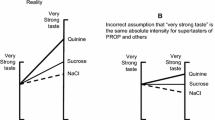Abstract
Introduction
Measurements of chemosensory function within specific regions of the tongue can yield important information about the sensitivity of lingual areas to chemosensory stimuli and may identify possible nerve damage. A novel regional chemosensory test that uses thin edible circles was developed for human testing.
Methods
Edible circles placed at six different regions of the tongue were used to examine regional sensitivity to quinine for bitter taste, NaCl for salt taste, sucralose for sweet taste, and capsaicin for pungency. The six regions included the anterior tip of the tongue, the left and right lateral margins of the tongue (anterior and posterior), and the circumvallate region. Testing was completed with the mouth open, and the mouth closed.
Results
Intensity ratings at all sites were higher in the closed mouth condition for the three taste stimuli. Quinine intensity was highest at the circumvallate region with the mouth closed. NaCl and sucralose intensity were highest at the anterior tip and circumvallate regions. Capsaicin intensity was most highly perceived at the anterior tip of the tongue, but open and closed mouth intensity ratings showed no significant differences.
Conclusions
Regional differences in chemosensory perception were observed on the tongue, and these differences were dependent on the chemosensory stimulus, tongue region, and tasting mode.
Implications
Edible circles show minimal diffusion with saliva, can be used to examine both taste and irritation, and may be used to identify regional papillae counts on the tongue. Finally, edible circles should be invaluable for examining damage to the oral cavity.






Similar content being viewed by others
References
Bartoshuk LM, Duffy VB, Reed D, Williams A (1996) Supertasting, earaches and head injury: genetics and pathology alter our taste worlds. Neurosci Biobehav Rev 20:79–87. https://doi.org/10.1016/0149-7634(95)00042-D
Bartoshuk LM, Duffy VB, Green BG, Hoffman HJ, Ko CW, Lucchina LA, Marks LE, Snyder DJ, Weiffenbach JM (2004) Valid across-group comparisons with labeled scales: the gLMS versus magnitude matching. Physiol Behav 82:109–114. https://doi.org/10.1016/j.physbeh.2004.02.033
Bartoshuk LM, Snyder DJ, Grushka M, Berger AM, Duffy VB, Kveton JF (2005) Taste damage: previously unsuspected consequences. Chem Senses 30:i218–i219. https://doi.org/10.1093/chemse/bjh192
Bartoshuk LM, Catalanotto F, Hoffman H, Logan H, Snyder DJ (2012) Taste damage (otitis media, tonsillectomy and head and neck cancer), oral sensations and BMI. Physiol Behav 107:516–526. https://doi.org/10.1016/j.physbeh.2012.06.013
Coldwell SE, Drangsholt MT, Huggins KH, Garson G, Scott MK, Hagstrom MK, LeResche L (2011) Reliability of a brief spatial test for assessment of gustatory function. Chem Senses 36:A24
Coldwell SE, Mennella JA, Duffy VB, Pelchat ML, Griffith JW, Smutzer G, Cowart BJ, Breslin PA, Bartoshuk LM, Hastings L, Victorson D, Hoffman HJ (2013) Gustation assessment using the NIH Toolbox. Neurology 80(11 Suppl 3):S20–S24. https://doi.org/10.1212/WNL.0b013e3182872e38
Colvin JL, Pullicin AJ, Lim J (2018) Regional differences in taste responsiveness: effect of stimulus and tasting mode. Chem Senses 43:645–653. https://doi.org/10.1093/chemse/bjy055
Delwiche J, Halpern BP, Lee MY (1996) A comparison of tip of the tongue and sip and spit screening procedures. Food Qual Prefer 7:293–297. https://doi.org/10.1016/S0950-3293(96)00008-0
Doty RL, Bagla R, Morgenson M, Mirza N (2001) NaCl thresholds: relationship to anterior tongue locus, area of stimulation, and number of fungiform papillae. Physiol Behav 72:373–378. https://doi.org/10.1016/S0031-9384(00)00416-9
Doty RL, Heidt JM, MacGillivray MR, Dsouza M, Tracey EH, Mirza N, Bigelow D (2016) Influences of age, tongue region, and chorda tympani nerve sectioning on signal detection measures of lingual taste sensitivity. Physiol Behav 155:202–207. https://doi.org/10.1016/j.physbeh.2015.12.014
Dunér-Engström M, Fredholm BB, Larsson O, Lundberg JM, Saria A (1986) Autonomic mechanisms underlying capsaicin induced oral sensations and salivation in man. J Physiol 373:87–96. https://doi.org/10.1113/jphysiol.1986.sp016036
Eldeghaidy S, Thomas D, Skinner M, Ford R, Giesbrecht T, Thomas A, Hort J, Francis S (2018) An automated method to detect and quantify fungiform papillae in the human tongue: validation and relationship to phenotypical differences in taste perception. Physiol Behav 184:226–234. https://doi.org/10.1016/j.physbeh.2017.12.003
Epstein JB, Smutzer G, Doty RL (2016) Understanding the impact of taste changes in oncology care. Support Care Cancer 24:1917–1931. https://doi.org/10.1007/s00520-016-3083-8
Feeney EL, Hayes JE (2014) Regional differences in suprathreshold intensity for bitter and umami stimuli. Chemosens Percept 7:147–157. https://doi.org/10.1007/s12078-014-9166-3
Green BG, Hayes JE (2003) Capsaicin as a probe of the relationship between bitter taste and chemesthesis. Physiol Behav 79:811–821. https://doi.org/10.1016/S0031-9384(03)00213-0
Green BG, Hayes JE (2004) Individual differences in perception of bitterness from capsaicin, piperine and zingerone. Chem Senses 29:53–60. https://doi.org/10.1093/chemse/bjh005
Hanig DP (1901) Zur psychophysik des Geschmackssines (to the psychophysics of taste). Phil Stud 17:576–623
Hawkes CH (2002) Anatomy and physiology of taste sense. Smell and taste complaints. Butterworth-Heinemann, Amsterdam, pp 123–145
Hebhardt P, Bagla R, Doty RL (1999) An automated regional taste-testing system. Behav Res Methods Instrum Comput 31:464–469. https://doi.org/10.3758/BF03200727
Kawakami S, Sato H, Sasaki AT, Tanabe HC, Yoshida Y, Saito M, Toyoda H, Sadato N, Kang Y (2016) The brain mechanisms underlying the perception of pungent taste of capsaicin and the subsequent autonomic responses. Front Hum Neurosci 9:720. https://doi.org/10.3389/fnhum.2015.00720
Kobayashi K, Kumakura M, Shinkai H, Ishii K (1994) Three-dimensional fine structure of the lingual papillae and their connective tissue cores in the human tongue. Kaibogaku Zasshi (J Anat) 69:624–635
Kroeze JHA, Bartoshuk LM (1985) Bitterness suppression as revealed by split-tongue taste stimulation in humans. Physiol Behav 35:779–783. https://doi.org/10.1016/0031-9384(85)90412-3
Kveton JF, Bartoshuk LM (1994) The effect of unilateral chorda tympani damage on taste. Laryngoscope 104:25–29. https://doi.org/10.1288/00005537-199401000-00006
Lawless HT, Stevens DA (1988) Responses by humans to oral chemical irritants as a function of locus stimulation. Percept Psychophys 43:72–78. https://doi.org/10.3758/BF03208975
Lehman CD, Bartoshuk LM, Catalanotto FC, Kveton JF, Lowlicht RA (1995) Effect of anesthesia of the chorda tympani nerve on taste perception in humans. Physiol Behav 57:943–951. https://doi.org/10.1016/0031-9384(95)91121-R
Lyall V, Heck GL, Vinnikova AK, Ghosh S, Phan TH, Alam RI, Russell OF, Malik SA, Bigbee JW, DeSimone JA (2004) The mammalian amiloride-insensitive non-specific salt taste receptor is a vanilloid receptor-1 variant. J Physiol 558:147–159. https://doi.org/10.1113/jphysiol.2004.065656
Manzi B, Hummel T (2014) Intensity of regionally applied tastes in relation to administration method: an investigation based on the “taste strips” test. Eur Arch Otorhinolaryngol 271:411–415. https://doi.org/10.1007/s00405-013-2748-x
Marlow CD, Winkelman RK, Gibilisco JA (1965) General sensory innervation of the human tongue. Anat Rec 152:503–511. https://doi.org/10.1002/ar.1091520410
Matsuda T, Doty RL (1995) Regional taste sensitivity to NaCl: relationship to subject age, tongue locus and area of stimulation. Chem Senses 20:283–290. https://doi.org/10.1093/chemse/20.3.283
McMahon DBT, Shikata H, Breslin PAS (2001) Are human taste thresholds similar on the right and left sides of the tongue? Chem Senses 26:875–883. https://doi.org/10.1093/chemse/26.7.875
Moon YW, Lee JH, Yoo SB, Jahng JW (2010) Capsaicin receptors are colocalized with sweet/bitter receptors in the taste sensing cells of circumvallate papillae. Genes Nutr 5:251–255. https://doi.org/10.1007/s12263-009-0164-z
Mu L, Sanders I (2010) Human tongue neuroanatomy: nerve supply and motor endplates. Clin Anat 23:777–791. https://doi.org/10.1002/ca.21011
Nasrawi CW, Pangborn RM (1990) Temporal effectiveness of mouth-rinsing on capsaicin mouth-burn. Physiol Behav 47:617–623. https://doi.org/10.1016/0031-9384(90)90067-E
Nilsson B (1979) Taste acuity of the human palate. III. Studies with taste solutions on subjects in different age groups. Acta Odontol Scand 37:235–252
Norton NS (2007) Netter’s head and neck anatomy for dentistry. Illustrations by Netter FH. Saunders Elsevier, Philadelphia, p 402
Ozkurt FE, Evcimik MF, Uğurlu B, Sapçı T, Gürsel AO (2011) Evaluation of loss of the chorda tympani function after myringoplasty. Kulak Burun Bogaz Ihtis Derg (J ear, nose, throat) 21:204–209. https://doi.org/10.5606/kbbihtisas.2011.027
Rentmeister-Bryant H, Green BG (1997) Perceived irritation during ingestion of capsaicin or piperine: comparison of trigeminal and non-trigeminal areas. Chem Senses 22:257–266. https://doi.org/10.1093/chemse/22.3.257
Roper SD (2014) TRPs in taste and chemesthesis. Handb Exp Pharmacol 223:827–871. https://doi.org/10.1007/978-3-319-05161-1_5
Roper SD, Chaudhari N (2017) Taste buds: cells, signals and synapses. Nat Rev Neurosci 18:485–497. https://doi.org/10.1038/nrn.2017.68
Rozin P (1982) “Taste-smell confusions” and the duality of the olfactory sense. Percept Psychophys 31:397–401. https://doi.org/10.3758/BF03202667
Satoh-Kuriwada S, Kawai M, Iikubo M, Sekine-Hayakawa Y, Shoji N, Uneyama H, Sasano T (2014) Development of an umami taste sensitivity test and its clinical use. PLoS One 9(4):e95177. https://doi.org/10.1371/journal.pone.0095177
Scully C (2013) Oral and maxillofacial medicine: the basis of diagnosis and treatment, 3rd edn. Churchill Livingstone/Elsevier, Edinburgh, pp 401–402
Shore LE (1892) A contribution to our knowledge of taste sensations. J Physiol 13:191–217
Simon SA, Gutierrez R (2017) TRP channels at the periphery of the taste and trigeminal systems. In: Emir TLR (ed) Neurobiology of TRP Channels, 2nd edn. Taylor & Francis Group, CRC Press, Boca Raton, FL, pp 113–124. https://doi.org/10.1201/9781315152837-8
Smith DV (1971) Taste intensity as a function of area and concentration: differentiation between compounds. J Exp Psychol 87:163–171
Smutzer G, Devassy RK (2016) Integrating TRPV1 receptor function with capsaicin psychophysics. Adv Pharmacol Sci 2016:1512457. https://doi.org/10.1155/2016/1512457
Smutzer G, Lam S, Hastings L, Desai H, Abarintos RA, Sobel M, Sayed N (2008) A test for measuring gustatory function. Laryngoscope 118:1411–1416. https://doi.org/10.1097/MLG.0b013e31817709a0
Smutzer G, Desai H, Coldwell SE, Griffith JW (2013) Validation of edible taste strips for assessing PROP taste perception. Chem Senses 38:529–539. https://doi.org/10.1093/chemse/bjt023
Smutzer G, Jacob JC, Tran JT, Shah DI, Gambhir S, Devassy RK, Tran EB, Hoang BT, McCune JF (2018) Detection and modulation of capsaicin perception in the human oral cavity. Phys Behav 194:120–131. https://doi.org/10.1016/j.physbeh.2018.05.004
Snyder DJ, Sims CA, Bartoshuk LM (2015) Psychophysical measures of human oral sensation. In: Doty RL (ed) Handbook of olfaction and gustation, 3rd edn. John Wiley & Sons, Inc., New York, pp 751–773. https://doi.org/10.1002/9781118971758.ch34
Acknowledgements
The authors thank Dow Chemical Co. for the hydroxypropyl methylcellulose, and Jacqueline Tanaka, Edward Gruberg, and Craig Brumwell for valuable discussions. An earlier version of this work was presented as an abstract at the 17th International Symposium of Olfaction and Taste (ISOT 2012).
Funding
This work was supported by NIDCD 2R44 DC007291 and funded in part by the URP program at Temple University.
Author information
Authors and Affiliations
Corresponding author
Ethics declarations
All protocols performed in this study were in accordance with ethical standards of the sponsoring university’s institutional review board. Informed consent was obtained from all subjects who participated in this study.
Conflict of Interest
The authors declare that they have no conflict of interest.
Additional information
Publisher’s Note
Springer Nature remains neutral with regard to jurisdictional claims in published maps and institutional affiliations.
Electronic Supplementary Material
ESM 1
(PDF 35 kb)
Rights and permissions
About this article
Cite this article
Abarintos, R.A., Jimenez, J.C., Tucker, R.M. et al. Development of a Regional Taste Test that Uses Edible Circles for Stimulus Delivery. Chem. Percept. 12, 115–124 (2019). https://doi.org/10.1007/s12078-019-09265-9
Received:
Accepted:
Published:
Issue Date:
DOI: https://doi.org/10.1007/s12078-019-09265-9




